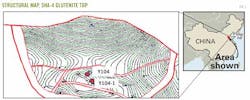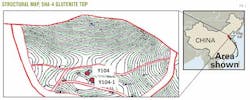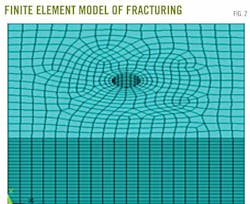Model optimizes sandstone-conglomerate fracturing in China
Weiqiang Feng
Sinopec Research Institute of Petroleum Engineering
Beijing
Qi Li
Xi’an Shiyou University
Shannxi, China
Jian Wang
Sinopec
Shandong, China
A stimulation model helped optimize hydraulic fracturing of a sandstone-conglomerate (glutenite) formation in the Bohan oil field in eastern China.
The formation is difficult to fracture because it has low maturity and texture, strong heterogeneity and anisotropy, and various porosity types.
Bonan field
Bonan oil field is in the Jiyang depression of the onshore Bohai basin, Eastern China (Fig. 1).
Discovered in May 2005 with wildcat well Y104, the reservoir has a 110-m thickness. After initial hydraulic fracturing, the well produced only 3.28 cu m/day.
The main reservoir, informally named the Sha-4 glutenite formation, is part of the Eocene Shahejie formation. The formation contains sediments that were deposited quickly and near the source of clastics.
The field has an estimated 14.5 million cu m of original oil in place and covers 9.11 sq km. Reservoir temperature is 141-150° C. at a 3,450-4,800 m depth. Reservoir thickness is 100-700 m.
The reservoir is a fan-shaped anticline structure that was uplifted from south to north. Stratigraphic dip is 2-6°, and the subsurface depth of the structural high is 3,540 m.
The presence of east west to east south, east north and north faults formed the trap that is compartmentalized in several structure blocks by secondary faults (Fig. 1).
The reservoir rocks are a conglomerate of pebbly sandstone, siltstone, andesite, dolerite, and dolomite siltstones. The reservoir has:
• A complicated content of 33.4% quartz, 31% feldspar, 35.6% lithic clastics, 13% clay, and 29.76% other clastics.
• Strong heterogeneity with a 1.685-4.113 sorting coefficient.
• Medium 0.05-0.017 mm grain size.
• Poor reservoir characteristics of mainly secondary dissolved porosity and muddy microporosity. Average porosity and permeability is 8.5% and 0.23 md, respectively.
• A strong water-wet and strong water sensitivity.
• An internal baffle zone with a poor seal in the vertical direction, based on composite log analysis.
Rock properties
Core analysis shows that the rock has low tensile and compressive strength, strong stress sensitivity, high plasticity, and high horizontal stress. Based on experiments, the rock’s mechanical parameters are 3.9 MPa tensile strength, 92 MPa compressive strength, 16,000 MPa elastic modulus, 0.27 Poisson’s ratio, and 0.513 Biot factor.
Stress sensitivity damage decreases core permeability by 74.67%.
Hydraulic fracturing simulation based on the rock properties and core experiments indicated that:
• Multifractures may form near the wellbore.
• Drainage area decreases because of the strong heterogeneity and poor reservoir properties.
• Fractures will grow beyond the formation in the vertical direction because of low stress difference between the pay zone and seal rock
• High plasticity will allow proppant to embed into the pay zone.
• Fracture conductivity will decrease.
• Fracture permeability will decrease because of the high stress sensitivity.
• Formation damage will occur because of high reservoir temperature and a strong water-wet rock.
The lithology and reservoir properties vary in the vertical and horizontal directions. The rock is poorly sorted and has poor connectivity.
Key elements in successful fracturing are the improving of fracturing fluid properties and controlling the geometry of the fractures to connect more drainage area.
Displaying 1/3 Page1, 2, 3Next>
View Article as Single page


